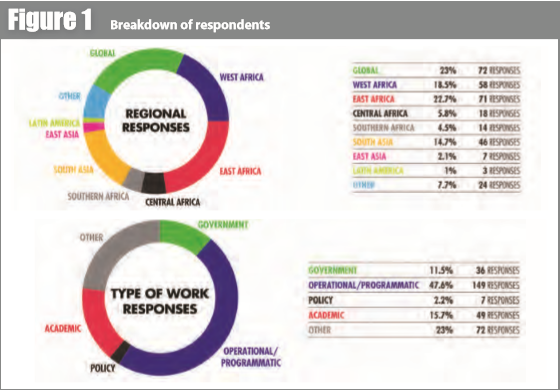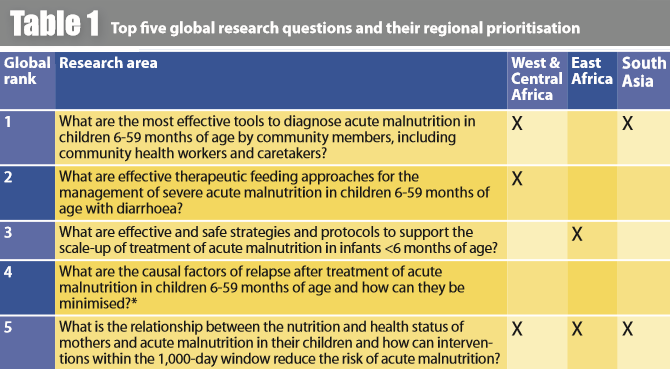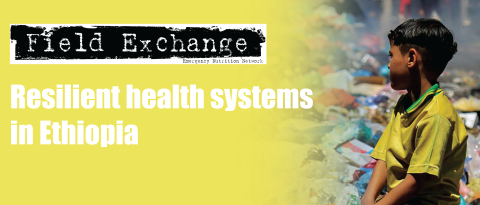Prioritising acute malnutrition research: preliminary results of a CHNRI survey
By Amy Mayberry and CORTASAM members
Amy Mayberry is Head of Evidence at Action Against Hunger, where she supports the technical and research activities of No Wasted Lives, including CORTASAM. She previously worked in the Evidence, Measurement & Evaluation Team at the Children’s Investment Fund Foundation (CIFF).
Members of the Council of Research & Technical Advice on SAM (CORTASAM) are: Nancy Aburto, Tahmeed Ahmed, Paluku Bahwere, Robert Black, André Briend, Elhadj Issakha Diop, Steve Jarrett, Marko Kerac, Ferew Lemma, Mark Manary, Marie McGrath, Susan Shepherd, Zita Weise Prinzo and Nöel Marie Zagre.
These are preliminary findings. The final findings are currently being prepared for publication in a peer-reviewed journal.
Background
As you will have read in the preceding articles in this issue of Field Exchange on No Wasted Lives and the Coalition of Research & Technical Advice on Severe Acute Malnutrition (SAM) (CORTASAM), our ambitions are large. A critical pillar of this effort to accelerate global action is driven by the generation and use of evidence. CORTASAM was founded to help fill gaps in the existing evidence base to support scale-up of effective programmes and drive the use of evidence for action. At the outset, it became evident that a set of research priorities would provide a fundamental platform to guide the work of the Council, as well as other researchers, implementers, policy-makers and donors. Where time, capacity and financial resources are limited, research priorities can focus efforts on the critical areas that will ultimately translate into meaningful action across programmes and policies. However, to be truly useful these research priorities need to reflect the opinions of the experts, the researchers and the implementers, like you, who are working every day to advance this field.
The scope of this exercise focused on research priorities related primarily to treatment across the continuum of acute malnutrition in children under five years of age. Given the state of evidence and other technical groups working on prevention, this exercise only included prevention where it was linked with treatment. The aim was to produce a set of research priorities that are critical to achieve measurable improvements in the quality, effectiveness, scale and sustainability of programmes addressing acute malnutrition in children under five years of age that will ultimately result in scaling up treatment by 2020.
Methods
To achieve this, CORTASAM led an exercise using the Child Health & Nutrition Research Initiative (CHNRI) methodology (Rudan et al, 2008) for setting research priorities. This exercise provides a robust and transparent framework to collect global, regional and country-level stakeholder feedback by scoring a set of research questions against a set of pre-defined criteria.
A long list of research questions was identified by collating published research questions and priorities from across the sector, including those previously identified by the World Health Organization (WHO), other technical interest groups and in a consultation with CORTASAM and additional regional stakeholders. This list of hundreds of questions reflects the breadth and depth of research areas and opportunities to support improvements and scale-up of cost-effective programmes for acute malnutrition, including new and innovative areas that are emerging.
The long list of research questions was grouped into 53 research areas which, while focused, would likely not be answerable by a single research study but could be collectively answered by a group of inter-related research studies.
An online survey was made available from 3 April to 5 May 2017. While CORTASAM members were invited to participate, the survey was also shared with global and regional staff in the No Wasted Lives coalition and with other researchers, implementers, academics and donors working in the sector.
The survey collected basic information on country/region of work, organisation and type of work for all respondents. The bulk of the survey focused on the research prioritisation, where each research area was scored against each of the following criteria:
- Impact: Would the research lead to interventions and solutions that provide the maximum potential impact (e.g. on global burden of acute malnutrition or mortality due to malnutrition) by 2020?
- Effectiveness: Would the research lead to interventions and solutions that are effective (e.g. under routine programme conditions) and deliverable (e.g. taking into account the health system infrastructure, human resources, safety)?
- Answerability: Is it possible to answer the question (is it feasible to implement within the given context and timeframe (by 2020)? Is it ethical?)
- Sustainability: Would the research lead to interventions and solutions that are sustainable (e.g. considering cost and financial affordability, cost-effectiveness, favourable political climate)?
Each of the 53 research areas received four scores (one per criteria) between 0 and 1. These were averaged to produce a single research priority score (RPS) that was used to produce the analyses. A global ranking analysis was done using all responses. In addition, regional analyses for West and Central Africa, East Africa and South Asia were undertaken using only responses from those regions.
Findings
A total of 313 unique responses were received; 143 (46%) of these were fully completed. These responses represented 63 different countries and 167 different organisations globally (see Figure 1). Nearly half of respondents (46.7%) identified their work as being primarily operational or programmatic; others reported to be working in academia (15%), government (11%), policy (2.2%), or in another type of work (23%). A full list of countries and organisations represented can be found at www.nowastedlives.org

The distribution of research priority scores (RPS) was relatively narrow. The average score was 0.83 (on a scale of 0 to 1) and 95% of scores fell between 0.73 and 0.94. Table 1 shows the top five priorities from the global analysis and indicates where they were also identified as a top five priority in the regional analyses.

*This question ranked number 8 in West & Central Africa, 11 in East Africa and 13 in East Asia.
Discussion
The strong regional and global response rates for this survey supported our belief that an exercise like this would be of great value across the sector and should be driven by the countries and regions where the burden is highest. By broadening the survey beyond CORTASAM, we achieved a larger sample and much wider view of priorities.
The preliminary findings presented here only include the top five research areas identified in the global analysis and where they are also a regional priority. This variation highlights the importance of the regional analyses for tailored discussions. We will release additional publications with the expanded findings and discussions from both the global and regional analyses in a peer-reviewed journal in 2017.
Our hope is that these findings will act as a platform for future conversations on the research priorities in the sector between now and 2020. More work needs to be done to unpack these research areas and understand the specific research questions that will drive the biggest change. It is also important to understand the existing evidence and ongoing research in order to identify the critical gaps that need to be addressed urgently. This initial mapping has begun and can be found here: www.severemalnutrition.org/en/content/ongoing-research.
Many technical interest groups (TIGs) are already leading excellent work to progress various priority research areas. Where this is not happening, we now have a tool to guide our collective efforts.
More information on this and related work of No Wasted Lives can be found at www.nowastedlives.org
References
Rudan I, Gibson JL, Ameratunga S, et al. Setting Priorities in Global Child Health Research Investments: Guidelines for Implementation of the CHNRI Method. Croatian Medical Journal. 2008;49(6):720-733. doi:10.3325/cmj.2008.49.720.


